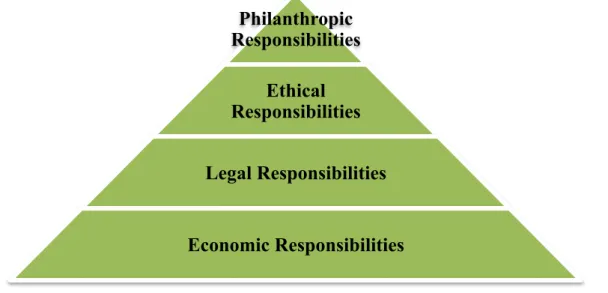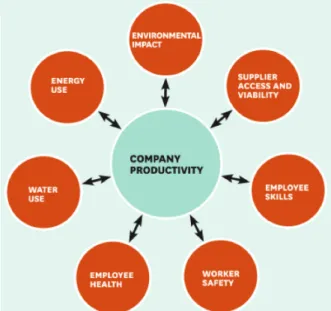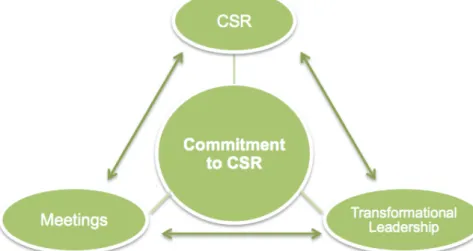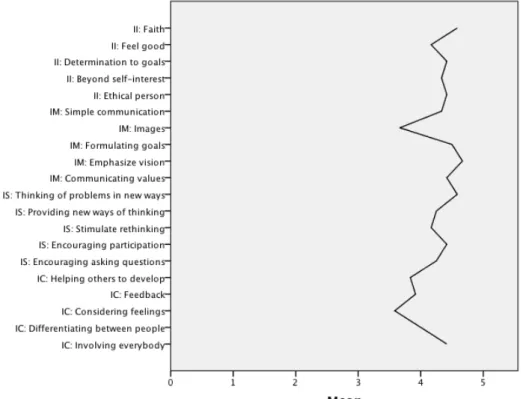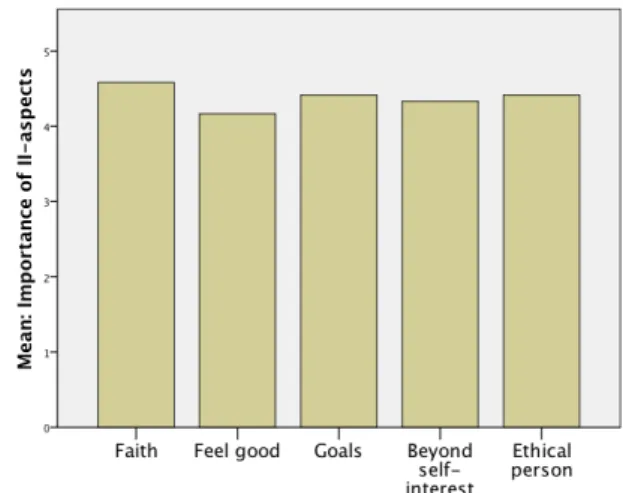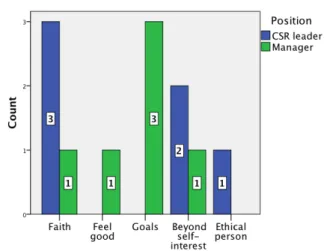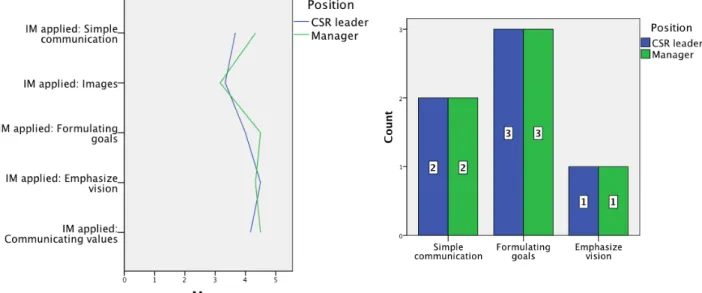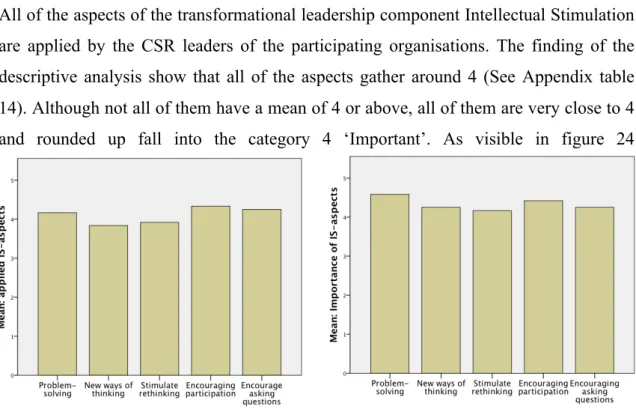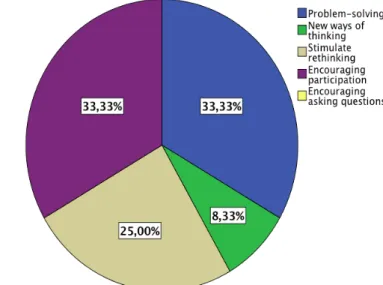HOW TO MOTIVATE MANAGERS FOR CSR?
COMMITMENT TO CSR BY
TRANSFORMATIONAL LEADERSHIP IN
MEETINGS.
Vanessa Vivian Wabitsch
Dissertation submitted as partial requirement for the conferral of Master in Marketing
Supervisor:
Prof. Eduardo Correia, ISCTE Business School, Department Marketing
HOW T O M OT IVAT E M ANAG E R S F OR C S R ? CO M M IT M E N T T O CS R BY TR A N S F O R M A T IO N A L LE A D E R SH IP I N M EE TI N G S. V an es sa V ivi an Wab it sc h
Abstract
Purpose: The aim of this research is to examine how it is possible to continuously
motivate managers from different departments for Corporate Social Responsibility (CSR). The goal is to investigate if and how CSR leaders can realize commitment to CSR by conducting meetings in transformational leadership style.
Methodology: The study uses a combination of theoretical and empirical research.
Theoretical research contracts and contrasts knowledge of the areas CSR, transformational leadership and meetings in new ways. By empirical research qualitative and quantitative data is attained by 12 interviews with CSR leaders and managers of 6 Australian organizations.
Findings: Transformational leadership clearly motivates managers for CSR in
meetings, because it enhances trust, understanding and commitment to CSR. All of the transformational leadership components are relevant and leaders can enhance them by specific behaviors. The motivational effects of various transformational leadership elements depend on characteristics of the audience such as position, gender, personality and experience.
Practical Implications: Leaders already apply the concepts of transformational
leadership, but it is recommended to increase its appliance for achieving optimal motivation. For realizing commitment leaders need to be aware of different impacts of transformational leadership elements and emphasize transformational leadership behavior in CSR meetings adjusted to the audience.
Limitations: Despite the sample size corresponds to academic standards of
qualitative research, there are limitations regarding the investigation of the effects of transformational leadership on different age groups, various industries, organization types or countries.
Key words: Corporate Social Responsibility, Transformational leadership, Meetings,
Motivation.
JEL Justification System: M10 – General; M14 – Corporate Culture; Social
Abstracto
Objectivo: O intuito de este trabalho de pesquisa é o de aferir a possibilidade de
motivar continuadamente administradores de vários departamentos, para factores de “Corporate Social Responsibility” (CSR). O propósito é então, investigar se e como vários lideres conseguem implementar CSR através de reuniões em estilo de liderança transformacional.
Metodologia: O corrente estudo usa uma combinação de investigação empírica e
teórica. Em termos teóricos, é procurado comparar e contrastar conhecimento nas áreas de CSR, liderança transformacional e novas formas de reuniões. A pesquisa empírica foca-se em 12 entrevistas com lideres em CSR e administradores de 6 organizações Australianas com o fim de recolher informação quantitativa e qualitativa.
Resultados: Liderança transformacional motiva claramente administradores para
aplicar CRS em reuniões, pois potencia sentimentos de confiança, compreensão e compromisso. Todos os componentes presentes na liderança transformacional são relevantes. Os efeitos de tais elementos contudo dependem das características da audiência: posição, gênero, personalidade e experiencia.
Implicações Praticas: Correntemente lideres já aplicam em algum grau estes
conceitos. Contudo, para atingir um ponto de motivação óptima, é necessário reforçar a aplicação de tais métodos e conceitos. Para conseguir reforçar o compromisso, lideres e administradores necessitam de ter em atenção os vários elementos da liderança transformacional e ajustar os seus comportamentos á audiência presente.
Limitações: Apesar do tamanho da amostra respeitar as normas acadêmicas de
estudos quantitativos, esse mesmo tamanho representa uma limitação, pois não é capaz de determinar os efeitos da liderança transformacional entre faixas etárias diferentes, industrias, tipos de organizações ou Países.
Palavras chave: Corporate Social Responsibility, Transformational leadership,
Meetings, Motivation.
JEL Justification System: M14 – Corporate culture; Social Responsibility, M10 –
To the beauty of this world that inspired me to write this dissertation and to all the wonderful people that supported and accompanied me
on my fabulous master journey. THANK YOU!
Index
1 Introduction ... 1
2 Definition of the problem ... 2
3 Research Objective ... 3
4 Research Questions and Hypotheses ... 4
5 Methodology ... 5
6 Theoretical research ... 7
6.1 Corporate Social Responsibility ... 7
6.1.1 History of CSR – Yesterday and today ... 7
6.1.2 What is CSR? ... 8
6.1.3 Business and CSR ... 12
6.1.3.1 Arguments for and against CSR ... 12
6.1.3.2 Why CSR? ... 13
6.1.3.3 The Business Case of CSR ... 15
6.1.4 CSR and Strategy ... 18
6.1.5 Implementation of CSR ... 20
6.1.6 Managers’ attitudes and commitment towards CSR ... 23
6.2 Leadership ... 25
6.2.1 What is leadership? ... 25
6.2.2 Theories and Concepts of Leadership ... 26
6.2.3 Leadership and CSR ... 28
6.2.1 Transformational leadership ... 30
6.2.1.1 What is transformational leadership? ... 30
6.2.1.2 Transformational leadership components ... 32
6.2.1.1 Transformational leadership and motivation ... 35
6.2.1.2 Transformational leadership and CSR ... 37
6.2.2 Leadership of CSR Meetings ... 39
6.2.2.1 Meetings and CSR ... 39
6.2.2.2 Transformational leadership and Meetings ... 41
6.2.2.3 Transformational Leadership in CSR Meetings ... 46
7 Empirical research ... 47
7.1 Data and Methods ... 47
7.1.2 Data Collection ... 49
7.1.3 Analysis ... 50
7.2 Research findings ... 51
7.2.1 The state of CSR today ... 51
7.2.2 Transformational leadership in CSR meetings ... 54
7.2.2.1 Transformational leadership in CSR meetings in practice ... 54
7.2.2.2 Importance of transformational leadership in CSR meetings ... 56
7.2.3 Components of transformational leadership in CSR meetings ... 59
7.2.3.1 Idealized Influence ... 59
7.2.3.2 Inspirational motivation ... 64
7.2.3.3 Intellectual Stimulation ... 70
7.2.3.4 Individual Consideration ... 76
7.2.3.5 Interconnection between the components ... 82
8 Discussion of results ... 83
9 Implications for Research and Practice ... 87
10 Limitations and Future Research ... 90
11 Conclusion ... 91
12 Bibliography ... 92
13 Appendix ... 101
13.1 Questionnaires ... 101
13.2 Codes and Themes of Qualitative Data ... 109
Index of Figures
Figure 1 CSR Definitions ... 9
Figure 2 The pyramid of Corporate Social Responsibility ... 10
Figure 3 Strongest connections between CSP and CFP ... 16
Figure 4 Porter's National Diamond applied to CSR ... 19
Figure 5 Implementation Framework ... 20
Figure 6 Definitions for Leadership ... 26
Figure 7 Levels of Conceptualization for Leadership Process ... 28
Figure 8 The link between CSR, Transformational Leadership and Meetings ... 46
Figure 9 Importance of Transformational leadership aspects ... 57
Figure 10 Means: Applied II - aspects ... 59
Figure 11 Means: Importance of II - aspects ... 59
Figure 12 Most important Idealized Influence-aspect ... 60
Figure 13 Importance of II-aspects: Leader/manager ... 60
Figure 14 Most important II-aspect: Leader/manager ... 60
Figure 15 Importance of II-aspects: Male/female ... 60
Figure 16 Most important II-aspect: Male/female ... 60
Figure 17 Means: Applied Inspirational Motivation aspects ... 64
Figure 18 Means: Importance of Inspirational Motivation aspects ... 64
Figure 19 Most important Inspirational Motivation-aspect ... 65
Figure 20 Importance of IM-aspects ... 66
Figure 21 Most important IM-aspect: Leader/manager ... 66
Figure 22 Importance of IM-aspect: Male/female ... 66
Figure 23 Most important IM-aspect: Male/female ... 66
Figure 24 Means: Applied Intellectual Stimulation aspects ... 70
Figure 26 Most important Intellectual Stimulation aspect ... 71
Figure 27 Importance of IS-apsects: Leader/manager ... 72
Figure 28 Most important IS-aspect: Leader/manager ... 72
Figure 29 Importance of IS-aspects: Male/female ... 72
Figure 30 Most important IS-aspect: Male/female ... 72
Figure 31 Means: Applied IC-aspects ... 77
Figure 32 Means: Importance of IC-aspects ... 77
Figure 33 Most important Individual Consideration aspect ... 77
Figure 34 Importance of IC-aspects: Leader/manager ... 78
Figure 35 Most important IC-aspect: Leader/manager ... 78
Figure 36 Importance of IC-aspects: Male/female ... 78
Figure 37 Most important IC-aspect: Male/female ... 78
Figure 38 Questionnaire CSR leaders ... 101
Figure 39 Questionnaire Managers ... 105
Figure 40 Theme 1: State of CSR ... 109
Figure 41 Theme 2: Idealized Influence ... 109
Figure 42 Theme 3 Inspirational Motivation ... 110
Figure 43 Theme 4: Intellectual Stimulation ... 110
Figure 44 Theme 5: Individual Consideration ... 111
Figure 45 Theme 6: Interconnection between transformational leadership components ... 111
Index of Tables
Table 1 Overlap of Transformational Leadership and ‘meetings guidelines’ ... 43
Table 2 Examined aspects of transformational leadership ... 49
Table 3 Means Transformational leadership in practice ... 54
Table 4 Mean: Importance of Transformational Leadership ... 56
Table 5 Transformational leadership: CSR leaders/managers ... 58
Table 6 Mean: Transformational leadership: CSR Male/female ... 58
Table 7 Validity of tests ... 112
Table 8 Gender of Sample ... 112
Table 9 Age of Sample ... 113
Table 10 Positions of Sample ... 113
Table 11 Industries of Sample ... 113
Table 12 Tests of Normality ... 114
Table 13 Transformational leadership in practice ... 116
Table 14 Means Transformational leadership in practice ... 117
Table 15 Transformational leadership in practice: Leaders/managers ... 117
Table 16 Crosstabulation Providing images*Position ... 118
Table 17 Crosstabulation Emphasize vision * Position ... 118
Table 18 Crosstabulation Encourage participation*position ... 119
Table 19 Crosstabulation Encourage asking questions * Position ... 119
Table 20 Crosstabulation Helping others to develop * Position ... 119
Table 21 Crosstabulation Involving*Position ... 119
Table 22 Means of Transformational leadership components ... 120
Table 23 Importance of Aspects of Transformational Leadership ... 120
Table 24 Descriptives: Transformational leadership - CSR leaders vs. managers .... 121
Table 26 Descriptives: Transformational leadership Males vs. Females ... 126
Table 27 Means Transformational Leadership Components: Males/Females ... 131
Table 28 Frequencies: Most important aspect of Idealized Influence ... 131
Table 29 Crosstabulation: Most important II-aspect*position ... 132
Table 30 Crosstabulation: Most important II-aspect*gender ... 133
Table 31 Frequencies: Most imortant aspect Inspirational Motivation ... 133
Table 32 Crosstabulation: Most important IM-aspect*position ... 134
Table 33 Crosstabulation: Most important IM-aspect*gender ... 134
Table 34 Frequencies: Most important aspect Intellectual Stimulation ... 135
Table 35 Crosstabulation: Most important IS-aspect*position ... 135
Table 36 Crosstabulation: Most important IS-aspect*gender ... 136
Table 37 Frequencies: Most important Individual Consideration aspect ... 136
Table 38 Crosstabulation: Most important IC-aspect*position ... 137
List of abreviations
CSR – Corporate Social Responsibility
II – Idealized Influence
IM – Inspirational Motivation
IS – Intellectual Stimulation
Executive Summary
The world is facing major challenges right now. This reflects not only in increasing societal problems and environmental disasters but also in the state of economy and business. The business environment is becoming more and more competitive and organizations are confronted with a change in consumer demands, increasing prices of resources and an unstable economy. Firms that want to be successful now and in future have to integrate Corporate Social Responsibility (CSR) and pay balanced attention to economic, social and environmental factors in driving business. For achieving a positive impact on the organizations’ outcomes as well as on economy, society and environment, CSR has to be fully embedded in organizations. Everybody has to be involved and committed to the process, because of the following reason: “If everyone is moving forward together, then success takes care of itself.” (Henry Ford). However, this process is hindered by the lack of understanding and motivation of managers and associates with other main responsibilities than CSR. The main challenge for CSR leaders is to bring everyone on board.
This study addresses the topic how it is possible to motivate managers from different departments (associates with other main responsibilities than CSR) for CSR in meetings. Meetings are a common internal communication tool with the disadvantage of being unpopular and boring. Therefore, this research deals with the issue how a leader should lead CSR meetings in order to realize commitment to CSR. Newest findings indicate that CSR is enhanced by transformational leadership - a leadership style in which leaders creates a vision, guides the change through inspiration and executes the change with the commitment of followers. Thus, the assumption of this study is that transformational leadership is a very good way to conduct CSR meetings and achieve motivation for CSR amongst managers. The aim of this research is to examine if CSR leaders can motivate followers by leading CSR meetings in the transformational leadership style and how they can achieve the highest motivation amongst followers for CSR.
Due to the fact that ‘transformational leadership in CSR meetings’ is a completely new research area this study looks into theory and practice. Theoretical research comprises investigation of the state of art of ‘transformational leadership and CSR’, as well as do the first steps into research areas ‘CSR meetings’, ‘Transformational
leadership in meetings’ to find out if managers can be motivated by transformational leadership in CSR meetings. Empirical research retests if commitment to CSR can be realized by transformational leadership in CSR meetings. 12 interviews (comprising questionnaires and qualitative talks) were conducted with CSR leaders and managers of 6 Australian organizations. Qualitative and quantitative data demonstrates which elements of transformational leadership are essential for motivating managers for CSR and the best way to emphasize them.
Both results of theoretical and empirical research show that transformational leadership clearly motivates managers for CSR. Theoretical findings show that meetings are a common and good internal communication tool to communicate a CSR strategy and transformational leadership is associated with CSR. Also, it proves that transformational leadership is a good way to conduct motivating meetings, because all the transformational leadership components Idealized Influence (II), Inspirational Motivation (IM), Intellectual Stimulation (IS) and Individual Consideration (IC) are part of guidelines of good meetings. Therefore, transformational leadership is a very good method to motivate managers for CSR in meetings.
Empirical research verifies that managers get motivated by transformational leadership in CSR meetings and further investigates its appliance in practice, the importance of transformational leadership elements and the behavior that is associated with transformational leadership. First, it is found that embedding CSR in firm structures and bringing people from different departments on one line are issues for all the organizations and CSR meetings are a common tool for communicating CSR. Results show that all the transformational leadership components are applied in practice by leaders already, but to a lower degree than they should be. Therefore, leaders should enforce them to reach optimal motivation. Second, results indicate that transformational leadership is central in motivating managers for CSR, because it enhances trust, commitment and understanding for CSR. All the transformational leadership components are important for motivating managers for CSR. The most important component is Idealized Influence, followed by Inspirational Motivation and Intellectual Stimulation. The least but still important one is Individual Consideration. Furthermore, it is found that the transformational leadership components IM, IS and IC are aligned and complement each other. Also, it is found which specific elements
of transformational leadership motivate followers depend on factors such as position, gender, personality and experience. Hence, CSR leaders should emphasize all of the transformational leadership elements and adjust it to the audience in order to achieve the highest possible motivation. Third, it is found that transformational leadership can be enforced by specific behavior and actions of leaders. In order to realize Idealized Influence a CSR leader has to show determination to goals and go beyond self-interest in order to realize faith and respect of the audience. For inspiring followers (Inspirational Motivation) it is recommended to communicate goals and vision in a simple and clear way. Intellectual Stimulation can be achieved by enabling participation and stimulate rethinking and problem solving. And, followers feel personally considered (Individual Consideration) by involving them and giving individual feedback. By adopting these behaviors CSR leaders can enforce transformational leadership in CSR meetings.
All in all, this research demonstrates the relevance of continuously motivating managers due to increasing importance of CSR for organizations and the lack of understanding for CSR amongst managers. Transformational leadership in CSR meetings is proved to be already part of daily business and highly important to realize commitment amongst managers for CSR in meetings and leaders can adopt it by specific behaviors in practice. By emphasizing transformational leadership elements in CSR meetings, leaders turn today’s challenge into the opportunity of creating an organization of highly motivated managers, who outstandingly drive a CSR strategy together and realize business success jointly. Simultaneously, they contribute to the well-being of society and environment and make the world a better place.
Executive Summary (Portuguese)
O mundo em que vivemos depara-se com um grande conjunto de desafios. Isto é reflectido não apenas pelos problemas sociais e desastres ambientais, como também com o estado da Economia. O ambiente empresarial está a ficar cada vez mais competitivo, e as organizações veem-se confrontadas com mudanças nas preferencias dos consumidores, aumento dos preços de matérias primas e uma economia mundial instável. Para que as empresas sejam bem sucedidas em tal ambiente, é necessário que elas consigam integrar Responsabilidade Social Corporativa (CSR na sigla em inglês) e prestar atenção a factores econômicos, sociais e ambientais. Com a finalidade de obter um impacto positivo nos resultados das organizações, como também na economia, sociedade e ambiente, CSR tem de ser completamente incorporado nas empresas. Todas as pessoas devem involver-se e comprometer-se a tal processo. “If everyone is moving forward together, then success takes care of itself.” (Henry Ford). Contudo, este processo, na sua realização, é impedido ou prejudicado pela falta de compreensão e motivação de administradores e associados. O maior desafio dos defensores da sua implementação, é o de fazer com que todos, dentro da organização, estejam a bordo.
Este estudo aborda o tema de como é que possível motivar os gestores de diferentes departamentos (associados que tem outras responsabilidades que não as de CSR) para CSR em reuniões. As reuniões são uma ferramenta de comunicação interna comum, mas com a desvantagem de serem impopulares ou aborrecidas. Portanto, este estudo aborda a questão de como um líder deve conduzir tais reuniões, com o fim de inspirar um compromisso pelos outros agentes. Estudos recentes indicam que CSR é reforçada pela liderança transformacional - um estilo de liderança em que um líderes cria uma visão, inspira há mudança e executa-a com o compromisso dos seus seguidores. Assim, a hipótese deste estudo é que a liderança transformacional é uma boa forma de realizar reuniões de CSR e implementar motivação entre os gestores. O objectivo é então examinar se é possível motivar os responsáveis de outros departamentos através da liderança transformacional, e de que forma é que se pode atingir uma performance óptima.
Devido ao facto de que a liderança transformacional em reuniões de CSR ser uma área de desenvolvimento recente, este estudo inclui uma parte teórica e prática. A
parte teórica compreende a investigação do estado da "liderança transformacional e CSR”, bem como dar os primeiros passos em áreas de investigação sobre “reuniões CSR” e “Liderança Transformacional em reuniões” com o intuito de descobrir se os gestores podem ser motivados por uma liderança transformacional em reuniões CSR. É testado ainda empiricamente se o compromisso com a CSR pode ser obtido pela liderança transformacional em reuniões. Para tal, 12 entrevistas (incluindo questionários e conversas qualitativas) foram realizados com líderes e gestores de seis organizações Australianas. Dados qualitativos e quantitativos demonstram quais elementos integrantes da liderança transformacional são essenciais para motivar gestores para CSR e qual é a melhor maneira de enfatizar-los.
Tanto a componente teórica como a empírica, parecem indicar uma relação positiva entre liderança transformacional e motivação dos gestores para abracar as ideias propostas por CSR. Resultados teóricos demonstram que as reuniões são uma ferramenta de comunicação interna comum e boa para comunicar uma estratégia de CSR e liderança transformacional é geralmente associada a tal ideia. Além disso, é provado que a liderança transformacional é uma boa maneira de conduzir reuniões de motivação, pois todos os componentes de liderança transformacional; Influência Idealizada (II), Motivação Inspiradora (IM na sigla inglesa “Inspirational Motivation”), Estimulação Intelectual (IS na sigla inglesa “Intellectual Stimulation”) e Consideração Individual (IC na sigla inglesa “Individual Consideration”) fazem parte das diretrizes de como alcançar boas reuniões. Portanto, a liderança transformacional é um bom método para motivar gestores para essas reuniões. Estudos empíricos identificam que os administradores e outros responsáveis de departamentos, ficam motivados pela liderança transformacional em reuniões de CSR e ficam encorajados a aprofundar os seus conhecimentos sobre o tema. Em primeiro lugar, verifica-se que a incorporação da CSR em estruturas firmes e juntando pessoas de diferentes departamentos são questões para todas as organizações, e reuniões de CSR são uma ferramenta importante para o fazer. Resultados demostram que todos os componentes de liderança transformacional já são aplicadas na prática pelos líderes organizacionais, mas em menor grau do que deveriam e como tal, deve ser promovido um maior esforço. Em segundo lugar, os resultados indicam que a liderança transformacional é fundamental para motivar os gestores para a CSR, uma vez que aumenta a confiança, comprometimento e entendimento para esse fim. Todos
os componentes de liderança transformacional são importantes para motivar os gestores, contudo, o componente mais importante é a Influência Idealizada, seguido pela Motivação Inspiradora, a Estimulação Intelectual e por ultimo Consideração individual. Além disso, é de notar que este componentes de liderança, IM, IS e IC, estão alinhados e se complementam. Líderes que promovem CSR devem enfatizar todos esses elementos e ajustá-los para o público alvo, a fim de alcançar o maior motivação possível. Em terceiro lugar, verifica-se que a liderança transformacional pode ser posta em pratica por comportamentos e ações específicos dos líderes. Para conseguir influenciar de uma forma ideal (II) o líder tem de mostrar determinação e orientação para objetivos e ir além do seu auto-interesse, a fim de conseguir o respeito do seu público. Para inspirar seguidores (IM) é recomendado que seja feita uma comunicação objetiva e de uma forma simples e clara. A IS pode ser atingida ao possibilitar a participação durante as reuniões e incentivar soluções alternativas para os problemas. Desta forma, todos os intervenientes se sentem importantes e que as suas considerações realmente importam, atingindo assim o elemento IC. Ao adoptar estes comportamentos líderes de CRS podem reforçar liderança transformacional nas reuniões.
Em suma, este estudo demonstra a importância de motivar continuamente os gestores, devido à crescente importância de CSR para as organizações e da falta de entendimento desses mesmo gestores para tal tópico. Liderança transformacional em reuniões CSR já faz parte do dia a dia de varias organizações e portanto, é fundamental perceber os seus elementos específicos e aplica-los correctamente. Ao enfatizar elementos de liderança transformacional em reuniões CSR, os líderes conseguem transformar o desafio e potenciais problemas numa oportunidade de criar uma organização de gestores altamente motivados, que conseguem conduzir uma estratégia CSR, e ao mesmo tempo, perceber como obter sucesso trabalhando em conjunto. Desta forma, ao mesmo tempo, eles contribuem para o bem-estar da sociedade e do meio ambiente, tornando o mundo num lugar melhor.
1 Introduction
When the wind blows, there are those that build walls and then there are those that build windmills. (Anonym)
The world is getting windy. The planet’s resources are on its limits and societal problems are increasing. Regarding today’s competitive business environment, changing societal values and consumer demands, business is facing change. Those organizations that want to be successful now and in future have to integrate Corporate Social Responsibility (CSR) and to consider economic, social and environmental factors equally. Structures are getting changed and new nature of business evolves. Managers throughout the organization are involved in this process, but currently they lack of understanding. A common tool for implementing CSR strategies are meetings that are perceived widely as boring. These windy developments demonstrate challenges for leaders. They can either do business in the old ways and build a wall or take up the opportunity and build windmills.
The objective of this dissertation is to contribute in building a windmill and find out how a CSR leader can motivate managers from different departments for CSR. More precisely, the topic of this study is how CSR leaders should conduct CSR meetings in order to achieve the most motivation amongst managers (associates with other main responsibilities than CSR). The assumption of this study is a leader can realize the highest commitment to CSR by transformational leadership. In order to find out if and how motivation amongst managers can be realized by transformational leadership in meetings the topic will be investigated thoroughly. In the beginning, the problem, research objective and research questions and hypothesis will be defined. Then, the topics CSR and leadership will be deeply examined in theory. This includes not only defining CSR and leadership, but also exploring the state of art of ‘Transformational leadership and CSR’ and doing the first steps into the research areas ‘Transformational leadership and meetings’ and ‘Transformational leadership in CSR meetings’. Afterwards, it will be investigated by empirical research if and how it is possible to realize commitment amongst managers to CSR by transformational leadership in meetings. This new knowledge should help to build a windmill of outstanding leadership in order to motivate people for CSR in meetings, to become a leading business and at the same time to have a positive impact on society and environment.
2 Definition of the problem
Although sustainable practices are increasingly implemented for moral as well as for business reasons in the last years, the majority of managers (persons who are responsible for other tasks and issues than CSR in a firm) still see CSR and business as two separate issues. The common mindset is that responsible business cost money instead of bringing profits. That’s why there is lack of motivation amongst managers to conduct a CSR strategy and in economical hard times the first action is budget cut of the CSR department (Gray, 2009). Since CSR is more and more embedded in the business strategy, CSR becomes relevant to all the people of a company throughout all departments (Makower, 2013). There is no clear definition of corporate social sustainability in general. The wrong understanding of CSR leads to lack of commitment and motivation to conduct a CSR strategy amongst the managers. The lack of understanding and motivation amongst managers for CSR is impeding the implementation of a CSR strategy (Vox Global, 2012). This demonstrates a problem for the CSR leader, the whole business and the society at large.
Strong leadership is essential to implement sustainable practices (Hohnen, 2007). Although there is a lot of research about CSR and leadership they are rarely talked about in one sentence. There is very little theoretical and sound empirical research on the leadership aspect of CSR (Velsor, 2009). So far it is found that transformational leadership enhances CSR practices in general (Du, Swaen, Lindgreen, & Sen, 2012; Strand, 2011), but there is no common knowledge about how to enforce strong leadership or transformational leadership of CSR in theory and practice. It is known that good communication is one of the most important aspects for successful leadership of CSR (Vox Global, 2012). A very good and common way to communicate a CSR strategy continuously is by meetings. Meetings provide a good tool to interact, communicate doubts and misunderstandings can be clarified. Furthermore, meetings are a good opportunity to bring all departments on one line. However, it is a fact that the majority of the managers find meetings boring (Lencioni, 2004). The negative attitude of managers towards the tool meetings makes motivating managers for CSR even more problematic. However, so far there is little research in the area leadership and meetings and no research about leadership and CSR meetings (Ravn, 2013). All in all, the
research problem is lack of motivation of managers for implementing CSR that is based on lack of leadership and communication.
3 Research Objective
The aim of this study is to find a solution of the problem how a CSR leader can motivate managers for implementing a CSR strategy continuously. The goal is to find a way to lead CSR that increases understanding and commitment to CSR and leads to long-term motivation for implementing sustainable practices. An important step of implementing a CSR strategy is its internal communication to all people throughout a firm that are involved. Meetings are a common and often used communication tool for implementing sustainable practices. They are good tools for enhancing commitment to CSR due to its interactive and participative elements. Due to their unpopularity amongst attendees, the intention of this research is to find a way to lead them in a motivational way in general and especially regarding CSR. It should be analysed how a leader can arise motivation for CSR through the interaction between leader and follower in a meeting. It is proven by various studies that a successful way of leading CSR is transformational leadership (Du et al., 2012; Strand, 2011). Since transformational leadership is known for its motivational effect (Bass, 1985) and enhances CSR implementation, it could be the solution for leading motivational CSR meetings. The goal is to find out if transformational leadership is also a successful way to lead CSR meetings and enhance commitment for CSR. This will show a new way to motivate managers for CSR in meetings. Doing this, the concepts CSR, transformational leadership and meetings need to be related in new ways. It will be contributing not only to the research area of ‘transformational leadership in CSR meetings’ but also to the fields ‘CSR and transformational leadership’, ‘transformational leadership and meetings’ and ‘CSR and meetings’. In addition to contribute to CSR and leadership on an academic level, the aim of this research is to enhance the CSR practice. The purpose of this research is to provide knowledge that can be directly used in practice by CSR leaders in order to facilitate implementation of CSR practices. It should be examined how a leader should behave and act in a CSR meeting in order to motivate associates for CSR. To sum it up, the objective of the study is to find out how a CSR leader is able to motivate managers for CSR in meetings by applying transformational leadership. By
achieving this it will be contributing to successful implementation of CSR practices in a short-term perspective and it will be improving the state of business, society and environment in the long run.
4 Research Questions and Hypotheses
In order to find a solution to be able to motivate managers of different areas for implementing CSR practices the first question of research that comes up is:
RQ1: How is it possible to motivate managers of different departments for CSR on an
ongoing basis?
For motivation understanding, trust and commitment are essential and communication is elementary for realizing understanding, trust and commitment. The internal communication tool meetings is a very important instrument in the continuous implementation of CSR (Hohnen, 2007). Also, it provides a platform of interaction and participation between a leader and a follower that is especially important for realizing commitment for CSR (Crane, Matten, & Spence, 2009). Regarding the negative attitude against meetings amongst attendees the question comes up is: How is it possible to lead motivating CSR meetings? Transformational leadership is famous for its motivational effect on followers (Bass, 1985). Additionally, various studies about CSR and leadership transformational leadership prove that transformational leadership is associated with CSR and enhances the implementation of CSR (Du et al., 2012; Groves & LaRocca, 2011a; Shahin & Zairi, 2010). Therefore, it can be assumed that transformational leadership is a solution for leading motivational meetings, which is the first hypothesis:
H1: A CSR leader can motivate managers for CSR by using transformational leadership
in meetings.
If the three elements CSR, transformational leadership and meetings are interrelated with each other and enable commitment of managers for CSR the question of interest is: How can a leader motivate managers of different departments for CSR by using transformational leadership in meetings? In other words, the question of research is:
RQ2: How should a transformational leader behave and act in a CSR meeting in order
Transformational leadership behavior comprises four components – the four I’s of transformational leadership: Idealized influence, inspirational motivation, intellectual stimulation and individual consideration (Bass, 1985). Scholars assume a link between the components of transformational leadership and CSR (Waldman & Siegel, 2008). Based on these assumptions the hypotheses are:
H2: Leaders motivate followers for CSR by behaving as a role model in a CSR
meeting.
H3: Leaders motivate managers by demonstrating vision, goals and values for
conducting a CSR strategy in a CSR meeting.
H4: Leaders motivate followers for CSR by stimulating them intellectually in a CSR
meeting.
H5: Leaders motivate managers for CSR by paying special attention to every person in
a CSR meeting.
In this research the validity of these hypotheses will be tested and further explored. If there is a correlation between the components of transformational leadership and motivation for CSR the following questions arise: What is the most important component of transformational leadership to motivate managers for CSR? How should a leader behave and act to fulfil the particular components of transformational leadership in CSR meetings? By answering all these questions the main question of research will be resolved: How to motivate managers for CSR?
5 Methodology
The best way to examine the topic ‘How to motivate managers for CSR in meetings by transformational leadership’ is to look into both theory and practice. Since it is a new field of research, it is necessary to analyse on a theoretical level if it is possible to motivate managers for CSR by transformational leadership in meetings at first. This will be done by analysing, correlating and connecting the elements CSR, transformational leadership and meetings. In fact, there is no research about the correlation CSR and meetings, and transformational leadership and meetings. Therefore, a profound examination about the interconnection of these elements is elementary. Through sound theoretical research, the link between those elements should
be proved and the theory should be explained how this leads to motivation amongst managers for CSR. In particular hypothesis 1 ‘A CSR leader can motivate managers for CSR by using transformational leadership in meetings.’ should be tested in the theoretical research.
Furthermore, empirical research is essential in this new and unexplored field of transformational leadership in CSR meetings. Qualitative semi-structured guided interviews will be held with CSR leaders and managers of sustainable organisations. Since the interaction between a leader and follower is explored, the point of view of both of them is crucial. The interview comprises two parts: A self administered questionnaire that is filled out in advance, and a talk of about 25-30 minutes that is relating to the topics of the questionnaire. This study utilizes a mixture between quantitative and qualitative methodology, because both have important elements that are contributing to the research. The advantage of quantitative methodology is to (1) get a lot of information, (2) capture clear answers and (3) get true responses for personal questions. Benefit of the qualitative method is (1) the possibility cope with the complexity of the topic and its elements CSR, motivation through transformational leadership and interaction in meetings; (2) getting new information that was unconsidered before, and (3) receiving detailed information. Due to these reasons, the mixture between quantitative and qualitative methodology is the best. However, regarding the complexity of the topics CSR, transformational leadership and interaction in meetings and the interconnections between topics the focus of the research lies on the qualitative analysis. By the qualitative and quantitative data, the theory about hypothesis 1 retrieved by the theoretical research should be tested again. Additionally, all other hypotheses will be examined by empirical research and further explored.
6 Theoretical research
6.1 Corporate Social Responsibility
6.1.1 History of CSR – Yesterday and today
In 1909, Lord Cadbury had to appear before court because his company had been buying slave-farmed cocoa bean in Africa.1 In 2000, British confectionary company Cadbury was again accused of the same offence – because of buying cocoa produced by slaves in West Africa. Both times the world’s second largest confectionary company lost in the court of public opinion. On one side, these events show that there are issues of ethical production that do disappear. On the other side, they prove that society has judged business from a moral perspective throughout the history. (Blowfield & Murray, 2008)
Hence, Corporate Social Responsibility is a new buzzword, but not a new concept. As long as business existed society had expectations about the responsibility of business (Haugland Smith & Oystein, 2006). Already ancient Chinese, Egyptian, and Sumerian cultures defined rules for commerce to ensure the wider public interests were considered. Since that time, public concern about the negative influence of business on society and social activism has grown in proportion of the corporate activity (Werther & Chandler, 2006). The idea of CSR as we understand it today began to evolve in the 1920s. Business executives began to ask for the need for corporate directors to act in a way to build up trust for shareholders. After several ups and downs during the Depression Decade and World War II, the idea of businesses’ responsibility towards the public flourished again and importance of the issue kept growing uninterruptedly until today (Frederick, 1994).
During the Industrial Revolution the necessity of social responsibility toward labor force was arising. Issues such as fair treating of employees and adequate wages fell under the understanding of CSR. From early 1900s until the middle of the twentieth century the company’s responsibility included society, stockholder and following governments regulations (Carroll, 2008; Evans, Haden, Clayton, & Novicevic, 2013).
1 Du Cann, R., 1993, ‚The Art of Advocate’ Harmondsworth: Penguin Books In: Blowfield M./ Murray
A., 2008, ‚Corporate Responsibility. A critical introduction.’, Oxford University Press, Oxford/New York.
Around the 1960s CSR started to include women’s rights, consumer rights and environmental concerns. It started in the 1970s, that CSR was formed by academic debates when the theories about CSR were emerging. Academics and practioners are debating until today about the essence of CSR. The understanding of the area and important issues are constantly changing (Carroll, 2008). Nowadays, CSR is more important than ever. It is not enough for companies to just earn profit anymore, they are also judged by their contributions to the world around them (Rowe, 2009). Furthermore, CSR is not only about business and charity activities anymore. There is a trend that CSR is embedded in a company’s culture and organizational profile to such an extent that it is not noticed, explicitly as CSR anymore (Hopkins, 2007). As sustainability is increasingly seen as business success, it has become a job for everyone. In a lot of large companies the head of the sustainability activity is not the sustainability manager anymore, but it can be located in departments such as purchasing, operations, facilities, fleets, energy, real estate or human resources (Makower, 2013). Furthermore, CSR is extending to small and medium-sized enterprises (Hopkins, 2007). Reasons for these trends are increasing demand, globalization and ecological sustainability (Werther & Chandler, 2006). On top of that, companies start thinking about global concerns as business risks. These concerns comprise availability of energy, water and raw materials and toxic products or manufacturing processes that can present perils all the way up the supply chains (Makower, 2013). Because CSR faces problems of the 21st century it achieves dominance as a global issue together with movements such as shared governance and regulatory challenges such as climate change, sustainable development, human rights, poverty eradication and socio-economic prosperity (Horrigan, 2010). Therefore, CSR has become one of the most important issues of the 21st century.
6.1.2 What is CSR?
Corporate Social responsibility is known under a number of names such as corporate responsibility, corporate accountability, corporate ethics, corporate citizenship or steward ship to just name a few of them (Hohnen, 2007). It is a broad field, that is multi- and interdisciplinary and contains multiple perspectives (Carroll, 1994). There are numerous of different definitions of various institutions. Three of them are shown in
Figure 1 CSR Definitions
However, despite the large amount of different definitions of CSR using different terminologies, the essence of the definitions of CSR are largely congruent. They share the common belief that businesses are more than just profit-seeking entities and, therefore, also have a responsibility to benefit society. In order to bring more clarity into the subject Dahlsrud (2006) analysed 37 existing CSR definitions. He defined CSR as a social construction specific to context and distinguished five emerging categories of CSR: the dimensions stakeholder, social, economic, voluntariness and environmental. The definition of the European Commission touches all five dimensions, whereas the definitions of WBCSD and World Bank both do not address the environmental dimension. For this reason, this definition is used for this research study.
The whole issue of CSR can be determined by the three words of that phrase: corporate, social, and responsibility. CSR is about the relationship and between corporations and societies and the responsibilities these relationships inherent (Werther & Chandler, 2006). The first question is: How can corporations be social? CSR defines society in a wide sense, in order to include all stakeholders and groups that have an ongoing interest in the organization’s operations. Werther and Chandler (2006) divided the firm’s stakeholders in three groups: organizational stakeholders (internal to the firm) and economic and societal stakeholders (external to the firm). The firm’s organizational stakeholders are employees, managers, stockholders and unions. The external stakeholders are economic stakeholders that comprise customers, creditors, distributors and suppliers and the societal stakeholders such as communities, government and regulators, NGOs and environment. Every company has to identify stakeholders in its operating environments and then set priorities and strategic importance to them. Increasingly, enterprises incorporate concerns of important stakeholders within the
(CSR is) a concept whereby companies integrate social and environmental concerns in their business operations and in their interaction with their stakeholders on a voluntary basis (EuropeanCommission, 2001).
Corporate Social Responsibility (CSR) is the commitment of business to contribute to sustainable economic development, working with employees, their families, the local community and society at large to improve quality of life, in ways that are both good for business and good for development (World Bank, 2003).
Corporate Social Responsibility is the continuing commitment by business to contribute to economic development while improving the quality of life of the workforce and their families as well as of the community and society at large (WBCSD, 2003).
organization’s strategic outlook. CSR helps firms in internal strategic planning to maximize the long-term viability of the organization (Carroll, 1991; Werther & Chandler, 2006). By considering the interests of all stakeholders and an organization acts socially.
The second question is: For what are corporations responsible? In order that a conscientious businessperson can accept and work with the term CSR it is necessary to frame the responsibilities of business towards society. Archie Carroll (1991) was one of the first academics that made a distinction between the different kinds of organizational responsibilities and introduced the concept as a firm’s ‘pyramid of corporate social responsibility’ (See Figure 2). He distinguishes four kinds of responsibilities of companies: economic, legal, ethical, and philanthropic that are based on each other.
Figure 2 The pyramid of Corporate Social Responsibility (Own creation).
Economic responsibilities are the base of the pyramid. Historically, the essence of business is to produce products and services that society wants at a profit. The profit motive is the primary incentive of entrepreneurship. Economic components include maximizing profits, commitment to being profitable, maintaining a strong competitive position and a high level of operating efficiency. Legal responsibilities as the second stage of the pyramid comprise obligations to fulfil economic mission within laws and regulations declared by federal, state or government. The third level includes ethical responsibilities that represent the standards, norms or expectations that consumers, employees, shareholders and community regard as being fair, just and moral. Corporate integrity goes beyond the legal stage and includes moral and ethical standards.
Philanthropic Responsibilities Ethical Responsibilities Legal Responsibilities Economic Responsibilities
Philanthropic responsibilities are on the top of the pyramid. Philanthropy encompasses being a good corporate citizen and engaging in activities for human welfare and goodwill such as charity, arts, education that enhance the community’s ‘quality of life’ (Carroll, 1991).
There are numerous theories and concepts from different disciplines that are trying to explain CSR, but no unifying corporate social responsibility theory. In order to bring structure into the subject, Garriga and Melé (2004) introduced (Garriga & Melé, 2004) a framework of classifying the main CSR theories and related approaches. They found that those theories are related to four aspects of social reality: economics, politics, social integration and ethics and introduced four groups. Group one relates to the economic aspect and could be also called instrumental theories, because they understand CSR as a means to the end of profits. It is assumed that the aim of a corporation is wealth creation and this is its social responsibility. The second group emphasize on the political dimension. This group of CSR theories focuses on interactions between business and society and corporations accept social duties and rights. The third group comprises the social aspect and include integrative theories. Organisations have to integrate social demands, because business and society are interdependent. Business relies on the community for its growth and existence and vice versa. The fourth group considers the ethical dimension of the relationship between business and society. The vision of CSR is determined by ethical values and companies have to accept social responsibilities as an ethical obligation. (Garriga & Melé, 2004).
Garriga and Melé’s classification of CSR theories goes along with Carroll’s concept of the ‘pyramid of corporate social responsibility’. Both concepts classify corporations responsibilities in four stages economic, political/legal, ethical and social/philanthropic. Based on this approach, Carroll created a four-part definition of CSR:
‘The social responsibility of business encompasses the economic, legal, ethical, and discretionary [later referred to as philanthropic] expectations that society has of organizations at a given point in time’ (Carroll, 1979).
Since this definition is academically widely accepted and used for research purposes for over 25 years, it is also a positive and appropriate perspective for this research. This definition is very useful since it includes the firm’s economic responsibility as an essential factor of CSR. Business people, in particular, usually think of their
economic/financial/profitability performance as something they are not only doing for themselves, but also for society in order to fulfil the mission of providing goods and services for society. Hence, including the economic responsibility into the definition is important in looking at how to motivate managers of different departments for CSR as a part of implementation of a CSR strategy (Carroll & Shabana, 2010).
6.1.3 Business and CSR
6.1.3.1 Arguments for and against CSR
Since the debate around CSR has started arguments for and against CSR have been exchanged. There are numerous reasons from the business point of view both for and against engaging in corporate social responsibility. The main argument against CSR is the classical economic argument of profit maximization articulated by Friedmann (1962). He argues that a management has only one responsibility and that is to maximize the profits of the company for owners and shareholders. He holds that social issues are not concern of managers and these problems should be solved by the workings of a free market system. In case the free market cannot solve a problem, it is governments’ and legislation’s responsibility to find a solution. The second argument against CSR is the lack of social skills of many businessmen. Business is not equipped to do social activities, because managers are oriented towards finance and operations and do not have the skills to make socially oriented decisions. A third objection to CSR is that social actions dilute business’s primary purpose. By emphasizing social goals reduces the emphasis on economic productivity, and divides the interests of its leaders that leads to a weakened position in the marketplace. The fourth argument is that business holds enough social power and it should not receive more power. Business influence is felt through society in education, government, home and marketplace. Hence, it should not become a giant social institution that dominates society (Davis, 1973).
However, there are numerous arguments for CSR. One of the most prevalent arguments for CSR is the long-run self-interest of business. It holds that it is in the interest of business to maintain a healthy climate for long-term profit maximization. Furthermore, by enhanced operational efficiency saves costs. For example, assessing environmental and energy aspects of operations are an opportunity to reduce energy use and costs and lead to revenue streams. The next argument is that responsible behavior of organizations
avoid government regulation that is costly and restricts business’ flexibility in decision-making. Another argument is that CSR helps to better anticipate and manage risk. By effectively managing governance, legal, social, environmental, economic and other risks, market security and stability can be enhanced. Moreover, social responsibility is in stockholder interest. Nowadays, shareholders increasingly look out for responsible organizations that are viable in the long-run. Furthermore supporters of CSR hold that business has the resources such as management talent, functional expertise, innovative ability and capital resources. CSR can favourably impact customer and employee relationship improving recruitment, retention, and workplace morale. Also, companies that are engaging in CSR attract and build effective and efficient supply chain relationships. Like-minded companies form together profitable long-term business relationships by improving standards and reducing risks. Additionally, innovative companies can uptake social concerns and create business opportunities. That way, social problems can become profit (Davis, 1973; Hohnen, 2007; USMotivation, 2008). Also, a justification for CSR is that it is that pro-acting is more practical and less costly than reacting. Another argument pro CSR is that public strongly supports is. Especially in the last decade with the up-coming climate change and other social concerns social norms changed. Today, public believes that business should be profitable, and in addition care for their workers, communities and other stakeholders. Engaging in CSR improves reputation and increases the public image that causes gain of customers, better employees and other benefits (Carroll & Shabana, 2010).
Some of these arguments – especially those against CSR - were introduced decades ago. In particular, the oppositions are applied to a CSR that was more narrowly defined. Ever since the field developed and the integration of CSR in business has changed. However, all the listed arguments are still prevalent and many people hold those or similar arguments in the discussion around CSR.
6.1.3.2 Why CSR?
Opponents and proponents are convinced by their point of view and there are studies that prove arguments of both sides. However, eighty-one per cent of executives from small, medium and large-sized enterprises said, in a 2005 survey, that CSR is essential to their business (Blowfield & Murray, 2008). Regarding this, the following questions
arise: Why do more and more organizations choose to engage in CSR? Why do they see CSR essential to business?
Nowadays, companies are more and more implementing CSR strategies not only because of moral, but also because of rational and economic reasons. The moral argument for CSR is that businesses realize that they are part of the society and success comes also from actions that are congruent with societal values. The rational argument for CSR is that involving social concerns leads to maximize performance and minimize restrictions on operations by government or social activists. And, the economic reason is that CSR adds value, because by reflecting the stakeholders’ needs and concerns a company retains its societal legitimacy and maximizes its financial viability over the long term. This leads to short-term profits by fulfilling shareholder interests. Furthermore, it enhances long-term profits by achieving legitimations and collective identity and stewardship interests (Aguilera, Rupp, Williams, & Ganapathi, 2007). CSR is essential since it influences all aspects of a company’s operations. Increasingly, consumers want to purchase products from companies they trust, suppliers look for reliable business relationships; employees want to work for companies they respect, stockholders and large investment funds want to invest in firms that are socially responsible and NGOs want to work with companies together that seek practical solutions for common goals (Werther & Chandler, 2006). Companies engage in CSR because it enhances reputation management and the ability to recruit, develop and retain staff, it builds a robust ‘social licence’ to operate in the community, it improves relations with regulators and suppliers and is a catalyst for responsible consumption. Nowadays, the most successful enterprises are those that are best able to balance the often conflicting interests of their multiple stakeholders. Carly, former chair and chief executive officer of Hewlett-Packard, said at the CEO summit in Shanghai:
‘I honestly believe that the winning companies of this century will be those who prove with their actions that they can be profitable and increase social value - companies that both do well and do good. (…) This is simply the new reality of business - one that we should and must embrace.’ (Fiorina, 2001)
CSR is increasingly an important element of business strategy for shareholders, customers, partners and employees, because of the following trends (Werther & Chandler, 2006):
1. Increasing Affluence
2. Changing Social Expectations
3. Globalization and Free Flow of Information 4. Ecological Sustainability
First, regarding the increasing global affluence consumers are more able to afford products of trustworthy companies which leads to a higher demand for CSR in organizations. Second, today consumers in developed societies expect more from the companies as the increasing number of corporate scandals demonstrates. Third, globalization and free information provided by global media conglomerates and the Internet facilitate that CSR lapses are published worldwide within a very short time. Fourth, ecological sustainability and the world being on its ecological limits is a major topic. Companies that harm the environment are criticized and penalized by fines and negative publicity. They face these challenges of today’s economy by engaging in CSR. The key potential benefits are better anticipation and management of an ever-expanding spectrum of risk, improved innovation, competitiveness and market positioning, enhances operational efficiencies and cost savings, enhanced ability to address change and access to capital. All in all, in today’s business world it has become crucial to engage in CSR to maintain a competitive position in the marketplace and a constantly growing number of companies realize that.
6.1.3.3 The Business Case of CSR
Since the rise of the debate around Corporate Social Responsibility the following question is predominant: ‘Can a firm really do well by being good?’ (Carroll & Shabana, 2010). Is Corporate Social Performance (CSP) positively related to Corporate Financial Performance (CFP)? The Business Case for CSR – which refers to the correlation between business performance and CSR activities – also known as the concept of Shared Value (SV), is one of the most important topics in this area. According to the Business Case the role of business is to create private value for itself, which in turn creates public value for society, manifesting itself as a win-win proposition. It is proving that there are sound business reasons to engage in CSR which
is not only important to CEOs and CFOs, but also to shareholders, social activists and customers.
The rationale of the business case for CSR can be divided in four categories: (1) reducing cost and risk, (2) strengthening reputation and legitimacy, (3) building competitive advantage, and (4) creating a win-win situation through synergetic value creation (Kurucz, Colbert, & Wheeler, 2008). Through cost and risk reduction an organisation can realize tax benefits, avoid strict regulation and opposition its stakeholders. Strong legitimacy and reputation of an organisation demonstrates that a company is able to meet the needs of its stakeholders and at the same time operate profitably. Competitive advantage arguments hold that by engaging in CSR a firm may build strong stakeholder relationships, lower employee turnover, access a higher talent pool and customer loyalty. This leads to differentiation of a company from competitors. By synergetic value creation it is possible to meet at the same time stakeholder needs and profit goals (Carroll & Shabana, 2010).
Porter and Kramer (2011) introduced the same idea as the concept of ‘Shared Value’ (SV). SV is about operating practices that enhance the competitiveness of a company while improving the economic and social conditions in the communities in which it operates. SV can be created by reconceiving products and markets, redefining productivity in the value chain, and building supportive industry clusters at the company’s locations. It focuses on identifying and
expanding the connections between competitive advantage and social issues. There are various ways in which social progress improve economic performance. Figure 3 demonstrates the areas where the connections are the strongest. All in all, successful corporations need a healthy society that consists out of well-educated and healthy workforce, efficient utilization of natural resources, a good government, law and regulations and demand for business (Porter & Kramer, 2006).
Figure 3 Strongest connections between CSP and CFP (Porter, 2011)
In the last decades there have been several studies about the CSP-CFP relationship. Griffin and Mahon (1997) determined a positive relationship between CSP and CFP by reviewing empirical studies. This study was criticised by Roman, et al. (1999) that stated that the studies fall in three categories: One category shows a positive link, the second category shows a negative link and the third shows no link. However, Walsh & Margolis (2003) analysed 127 empirical studies in order to explore the CSP-CFP relationship. They came to the conclusion that there is a positive CSP-CFP correlation and very little evidence that there is a negative association. In 2001, the consultancy company SustainAbility reviewed multiple reports, case studies and academic analyses and published a report for evidence of a business case for CSR. The main areas in which CSR has a strong correlation with business performance are eco-efficiency, protecting corporate reputation and risk management. The strongest contribution to a business’ financial performance is eco-efficiency (Blowfield & Murray, 2008). For example, Wal-Mart saved $200 million in costs and lowered carbon emissions by reducing its packaging and cutting 100 million miles form the delivery routes of its trucks (Porter & Kramer, 2011). Furthermore, there is also strong evidence that dimensions of CSR such as human rights, high-quality working conditions, relationships with external stakeholders, transparency and accountability are linked to better business performance. A neutral or negative relationship has dimensions such as ethics and values, engaging business stakeholders and social development to financial performance measures. Critics question evidence of the business case due to insufficient quality of methodology, unidirectional causality and inability to consider the broader context within companies operate (Blowfield & Murray, 2008).
All in all, there seems to be a positive relationship between a company’s social and financial performance. There is growing support for the business case amongst academic and practioners. Mediating variables and situational contingencies influence the CSP-CFP relationship. For this reason, it is important that companies adjust their CSR strategy and activities with their business objectives. Only if organisation pursue CSR activities that are supported by their stakeholders, there will be a business case for CSR (Carroll & Shabana, 2010).
